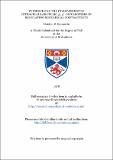Files in this item
Evidence for the involvement of intracellular cyclic 3', 5' - nucleotides in regulating miocardial contractility
Item metadata
| dc.contributor.advisor | Flitney, F. W. | |
| dc.contributor.advisor | Lamb, J. F. | |
| dc.contributor.author | Singh, Jaipaul | |
| dc.coverage.spatial | 247 p. | en_US |
| dc.date.accessioned | 2018-07-04T09:51:57Z | |
| dc.date.available | 2018-07-04T09:51:57Z | |
| dc.date.issued | 1978 | |
| dc.identifier.uri | https://hdl.handle.net/10023/14902 | |
| dc.description.abstract | An investigation was made into one aspect of the molecular control of cardiac contractility, namely, the putative role of the two endogenous cyclic 3',5'-nucleotides, adenosine cyclic 3',5' monophosphate (cyclic AMP) and guanosine cyclic 3',5' monophosphate (cyclic GMP) in regulating the capacity of the heart to produce force. It began as a study of a poorly understood but well documented effect of exogenous adenosine 5'-triphosphate (ATP) on the electrical and mechanical properties of the isolated frog ventricle. In common with several related purine and pyrimidine nucleotides, treatment of the ventricle with ATP elicits a characteristic triphasic response which is not blocked by either atropine or propranolol. Preliminary experiments with ATP led to the hypothesis that it exerts a dual effect on the heart. The two effects were attributed tentatively to the induction of elevated levels of intracellular cyclic AMP and cyclic GMP respectively. Indirect evidence for the involvement of cyclic nucleotides in mediating the ATP-induced response comes from studies with agents which are known to influence cyclic 3',5'-nucleotide metabolism on the form of the ATP-induced response. Measurements of endogenous cyclic 3',5'-nucleotides during the development of the hypodynamic state is associated by a gradual decline in intracellular cyclic AMP and a progressive increase in cyclic GMP. This gradual loss in contractility is also accompanied by the release of prostaglandins E1 and E2 and one or more prostaglandin-related substances into the perfusate. Subsequent experiments with exogenous ATP elicits profound changes in cyclic 3',5'-nucleotides. Both cyclic AMP and cyclic GMP are affected as had been postulated. A third series of experiments with the -agonist isoprenaline (isoproterenol) was undertaken to investigate the generality of the relationship between intracellular cyclic nucleotide levels and contractility, and this produced similar results. The most significant feature to emerge from the results was the finding that in all three responses, which on the face of it appear to be physiologically distinct and quite unrelated, changes in the ratio of intracellular cyclic AMP / cyclic GMP almost exactly parallel the observed changes in contractile force. This observation has led to the formulation of a hypothesis which postulates that both endogenous cyclic 3',5'-nucleotides are integral components of an intracellular control mechanism which is responsible for regulating the contractility of the amphibian ventricle. | en_US |
| dc.language.iso | en | en_US |
| dc.publisher | University of St Andrews | |
| dc.subject.lcc | QP113.2S5 | |
| dc.subject.lcsh | Myocardium | en |
| dc.title | Evidence for the involvement of intracellular cyclic 3', 5' - nucleotides in regulating miocardial contractility | en_US |
| dc.type | Thesis | en_US |
| dc.type.qualificationlevel | Doctoral | en_US |
| dc.type.qualificationname | PhD Doctor of Philosophy | en_US |
| dc.publisher.institution | The University of St Andrews | en_US |
This item appears in the following Collection(s)
Items in the St Andrews Research Repository are protected by copyright, with all rights reserved, unless otherwise indicated.

